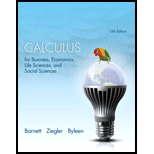
Concept explainers
It can be shown that
for any real number s. Illustrate this equation graphically for s = 2 by graphing
in the same viewing window, for 1 ≤ n ≤ 50.
Want to see the full answer?
Check out a sample textbook solution
Chapter 3 Solutions
Calculus for Business Economics Life Sciences and Social Sciences Plus NEW
- Complete solutions need handwriting. For all only sure experts solve it correct complete solutionsarrow_forwardThe graph below shows the U.S. federal expenses for 2012. A) estimate the fraction of the total expenses that were spent on Medicare. Write your answer as the closest fraction whose denominator is 100. B) estimate the fraction of the total expenses that were spent on Medicare and Medicaid. Write your answer as the closest fraction, whose denominator is 100.arrow_forwardStarting with the finished version of Example 6.2, attached, change the decision criterion to "maximize expected utility," using an exponential utility function with risk tolerance $5,000,000. Display certainty equivalents on the tree. a. Keep doubling the risk tolerance until the company's best strategy is the same as with the EMV criterion—continue with development and then market if successful. The risk tolerance must reach $ ____________ before the risk averse company acts the same as the EMV-maximizing company. b. With a risk tolerance of $320,000,000, the company views the optimal strategy as equivalent to receiving a sure $____________ , even though the EMV from the original strategy (with no risk tolerance) is $ ___________ .arrow_forward
- 2.8.1arrow_forwardDo not use the Residue Theorem. Thank you.arrow_forwardA television network earns an average of $14 million each season from a hit program and loses an average of $8 million each season on a program that turns out to be a flop. Of all programs picked up by this network in recent years, 25% turn out to be hits and 75% turn out to be flops. At a cost of C dollars, a market research firm will analyze a pilot episode of a prospective program and issue a report predicting whether the given program will end up being a hit. If the program is actually going to be a hit, there is a 75% chance that the market researchers will predict the program to be a hit. If the program is actually going to be a flop, there is only a 30% chance that the market researchers will predict the program to be a hit. What is the maximum value of C that the network should be willing to pay the market research firm? Enter your answer in dollars, not in million dollars. $ __________ Calculate EVPI for this decision problem. Enter your answer in dollars, not in million…arrow_forward
- Evaluate the line integral sin z dz, So sin where C is the portion of the curve y = x² from 0 to −1 + i.arrow_forwardLet f(z) be complex differentiable everywhere in C. Fix two distinct complex numbers a and b and a circle C of radius R with |a| < R,|b| < R traversed in the counter-clockwise direction. Evaluate the integral Sc − f(z)dz (z - a)(z – b) in terms of a, b and the values of f at those points.arrow_forward| Let C be a circle (with a positive radius) such that z = 1 lies in its interior. Evaluate the contour integral So Tz zez (z - 1)³ = where C is traversed in the clockwise direction. dzarrow_forward
- question 8arrow_forwardTwo construction companies are bidding against one another for the right to construct a new community center building. The first construction company, Fine Line Homes, believes that its competitor, Buffalo Valley Construction, will place a bid for this project according to the distribution shown in this table: Buffalo Valley's Bid Bid Probability $160,000 0.2 $165,000 0.5 $170,000 0.2 $175,000 0.1 Furthermore, Fine Line Homes estimates that it will cost $160,000 for its own company to construct this building. Given its fine reputation and long-standing service within the local community, Fine Line Homes believes that it will likely be awarded the project in the event that it and Buffalo Valley Construction submit exactly the same bids. Find the bid that maximizes Fine Line’s expected profit. Max expected profit $ ________ . Bid that maximizes profit $ ________ .arrow_forwardFind the area of the surface obtained by rotating the circle x² + y² = r² about the line y = r.arrow_forward

 Trigonometry (MindTap Course List)TrigonometryISBN:9781337278461Author:Ron LarsonPublisher:Cengage Learning
Trigonometry (MindTap Course List)TrigonometryISBN:9781337278461Author:Ron LarsonPublisher:Cengage Learning Glencoe Algebra 1, Student Edition, 9780079039897...AlgebraISBN:9780079039897Author:CarterPublisher:McGraw Hill
Glencoe Algebra 1, Student Edition, 9780079039897...AlgebraISBN:9780079039897Author:CarterPublisher:McGraw Hill Trigonometry (MindTap Course List)TrigonometryISBN:9781305652224Author:Charles P. McKeague, Mark D. TurnerPublisher:Cengage LearningAlgebra & Trigonometry with Analytic GeometryAlgebraISBN:9781133382119Author:SwokowskiPublisher:Cengage
Trigonometry (MindTap Course List)TrigonometryISBN:9781305652224Author:Charles P. McKeague, Mark D. TurnerPublisher:Cengage LearningAlgebra & Trigonometry with Analytic GeometryAlgebraISBN:9781133382119Author:SwokowskiPublisher:Cengage Functions and Change: A Modeling Approach to Coll...AlgebraISBN:9781337111348Author:Bruce Crauder, Benny Evans, Alan NoellPublisher:Cengage Learning
Functions and Change: A Modeling Approach to Coll...AlgebraISBN:9781337111348Author:Bruce Crauder, Benny Evans, Alan NoellPublisher:Cengage Learning





